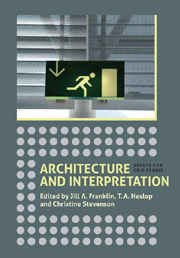Book contents
- Frontmatter
- Contents
- List of Illustrations
- Preface: In Appreciation
- List of contributors
- 1 Introduction
- Incitements to Interpret in Late Antique and Medieval Architecture
- Authors and Intentions
- 146 Home Sweet Mammoth: Neuroarchaeology and the Origins of Architecture
- 163 Constantine and Helena: The Roman in English Romanesque
- 176 For Their Monuments, Look about You: Medieval Masons and their Tombs
- 192 Baxandall's Bridge and Charles IV's Prague: An Exercise in Architectural Intention
- 221 Imitation as a Creative Vehicle in Michelangelo's Art and Architecture
- 242 The ‘Façade Problem’ in Roman Churches, c. 1540–1640
- Architecture beyond Building
- Index
192 - Baxandall's Bridge and Charles IV's Prague: An Exercise in Architectural Intention
from Authors and Intentions
Published online by Cambridge University Press: 05 April 2013
- Frontmatter
- Contents
- List of Illustrations
- Preface: In Appreciation
- List of contributors
- 1 Introduction
- Incitements to Interpret in Late Antique and Medieval Architecture
- Authors and Intentions
- 146 Home Sweet Mammoth: Neuroarchaeology and the Origins of Architecture
- 163 Constantine and Helena: The Roman in English Romanesque
- 176 For Their Monuments, Look about You: Medieval Masons and their Tombs
- 192 Baxandall's Bridge and Charles IV's Prague: An Exercise in Architectural Intention
- 221 Imitation as a Creative Vehicle in Michelangelo's Art and Architecture
- 242 The ‘Façade Problem’ in Roman Churches, c. 1540–1640
- Architecture beyond Building
- Index
Summary
MUCH RECENT WORK on the epistemology of art has centred on the mysteries of the creative process, which has come under critical scrutiny from psychologists, philosophers of aesthetics and the art historian. Does creativity in art call for special talents that distinguish the artist from the general run of human beings? Do ‘truly’ creative artworks add something of interest to the world – something above the routine and the derivative? Can the art historian dare to identify creativity in art with durable and constant appeal – or will s/he fall back on explanations of the creative in terms of the contingencies of social class, historical circumstance and gender difference?
Such questions raise special difficulties for the art historian, for whom the whole concept of agency has, in the last quarter century, become a battleground. The traditional, common-sense view that the meanings of works of art lie in the meanings given them by their creators can no longer be sustained. Psychoanalysis has confirmed what our experience tells us: that we have no means of knowing the inner complexities of our own psyche, let alone the inner experience of an artist and the ‘authentic’ meanings his work contains. Postmodernist deconstruction has alerted us to the ambiguities of the self and the complexities of self-expression by questioning the model of a stable consciousness and by situating meaning in a potentially endless process of ‘inter-textual’ signifying.
- Type
- Chapter
- Information
- Architecture and InterpretationEssays for Eric Fernie, pp. 192 - 220Publisher: Boydell & BrewerPrint publication year: 2012



